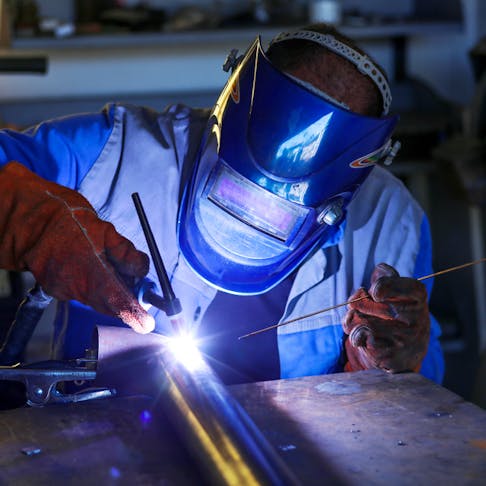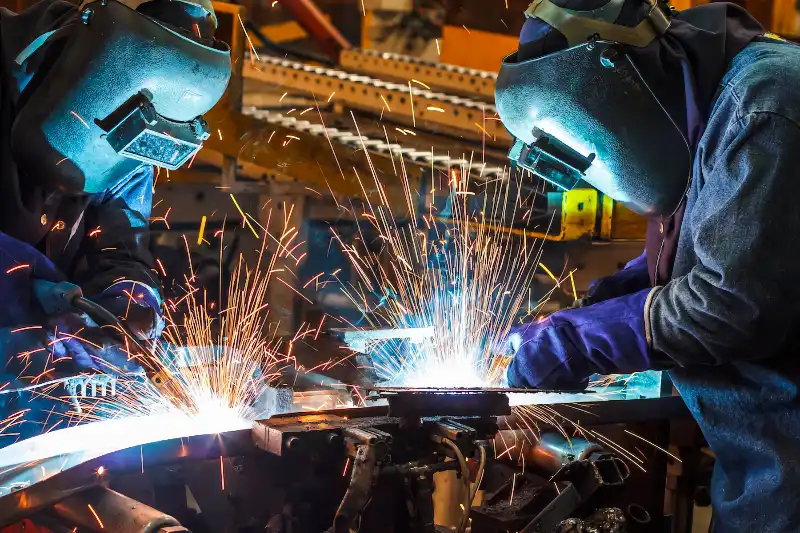Everything about Welding: Key Insights Into Techniques and Best Practices for Success
Welding encompasses a selection of techniques, each matched for details materials and applications. Understanding these techniques, such as GMAW, SMAW, and TIG, is essential for accomplishing suitable results. The best devices and safety practices can not be overlooked. As preparation and fixing play important duties in the welding procedure, mastering these components can considerably enhance the quality of the last product. What are the crucial elements that assure an effective weld?
Understanding Various Welding Techniques
Welding strategies encompass a range of techniques, each matched to particular applications and products. Amongst the most usual strategies are Gas Metal Arc Welding (GMAW), Secured Steel Arc Welding (SMAW), and Tungsten Inert Gas Welding (TIG) GMAW, additionally referred to as MIG welding, is preferred for its speed and convenience, making it perfect for thin materials. SMAW, or stick welding, is favored for its simplicity and efficiency in outdoor environments, specifically with thicker metals. TIG welding provides precision and control, making it appropriate for intricate work and non-ferrous steels (Montana Mobile Welding and Repair Belgrade Fabrication). Each method has its special benefits and considerations, allowing welders to select the most effective technique based upon the job's needs, material type, and preferred results. Comprehending these methods is crucial for effective welding
Crucial Welding Tools and Tools
While numerous welding methods require particular abilities, the right tools and devices are just as necessary for accomplishing quality outcomes. Important welding devices includes welding makers, which vary depending on the method-- such as MIG, TIG, or stick welding. Protective equipment, including helmets, aprons, and gloves, assurances safety and security and convenience throughout the process. In enhancement, components and clamps aid safeguard materials in position, making certain accuracy in welds. Consumables like welding poles, cord, and shielding gas are likewise crucial parts that affect the high quality of the weld. Furthermore, tools such as cutters and mills promote surface area prep work and post-weld ending up, adding to a professional result. Spending in high-quality devices eventually enhances the efficiency and performance of welding jobs.
Security Practices in Welding
Correct safety and security techniques are vital in the welding sector to secure employees from possible threats. Welders need to put on suitable individual protective equipment (PPE), including headgears with correct shading, handwear covers, and flame-resistant garments. Ample air flow is important to reduce direct exposure to harmful fumes and gases produced during the welding procedure. Additionally, employees should be learnt the right handling of welding equipment to prevent accidents. Fire precaution, such as maintaining combustible products away from the welding area and having fire extinguishers conveniently available, are necessary. Routine examinations of devices and workspaces can help identify potential risks prior to they cause accidents. By sticking to these security methods, welders can produce a safer working environment and lessen dangers linked with their trade.
Preparing Products for Welding
Preparing materials for welding is a vital step that substantially affects the quality and honesty of the end product (Montana Mobile Welding and Repair Belgrade). Correct prep work entails cleaning up the surfaces to remove contaminants such as dirt, corrosion, and oil, which can jeopardize the weld. Methods such as grinding, sanding, or utilizing solvents are typically employed to achieve a tidy surface area. Additionally, guaranteeing that the materials mesh snugly is essential; gaps can cause weak welds. It's additionally crucial to take into account the positioning and positioning of the components, as this will certainly affect the simplicity of welding and the last result. Finally, picking the suitable filler material and guaranteeing compatibility with the base steels is essential for attaining solid, resilient welds
Tips for Getting High-Quality Welds
Attaining high-grade welds calls for attention to detail and adherence to finest methods throughout the welding process. Correct joint prep work is essential, making certain surfaces are complimentary and tidy from pollutants. Selecting the suitable filler product and welding method based on the base steels is important for suitable bonding. Keeping constant travel rate and angle while welding can prevent issues and advertise harmony. Furthermore, managing heat input is necessary; extreme warm can cause warping and weakened joints. If necessary, regularly checking the welds throughout the procedure allows for instant adjustments. Using ideal post-weld treatments, such as cleaning and anxiety relief, can enhance the sturdiness and honesty of the weld, inevitably making sure a successful end result.
Troubleshooting Common Welding Issues
Welding typically provides challenges that can impact the top quality and stability of the end product. Common problems such as porosity, irregular weld grains, and getting too hot can develop, each needing details troubleshooting techniques. Understanding these issues is crucial for welders to boost their abilities and attain optimal outcomes.
Porosity Troubles Clarified
Although porosity can often be forgotten, it continues to be an important problem in welding that can endanger the stability of a completed product. Porosity refers to the visibility of little gas pockets within the weld bead, which can damage the joint and lead to premature failing. This issue commonly occurs from contaminants, wetness, or inappropriate protecting gas protection during the welding process. To alleviate porosity, welders need to confirm that the base materials are completely dry and clean, make use of suitable protecting gases, and maintain constant welding specifications. On a regular basis checking the equipment and setting can additionally aid identify possible concerns before they show up in the weld. Attending to porosity effectively is important for achieving solid, sturdy welds that satisfy quality standards.

Irregular Weld Beans
Irregular weld grains can considerably impact the high quality and stamina of a completed product. Various factors contribute to this concern, including improper traveling rate, incorrect amperage settings, and irregular electrode angles. When the welder moves also promptly, a grain may show up slim and do not have infiltration, while moving also slowly find more info can trigger too much buildup. In addition, utilizing the wrong amperage can cause either undercutting or extreme spatter, both of which compromise weld stability. The welder's strategy, such as irregular torch activity, can also cause irregular grain appearance. To minimize these problems, welders ought to focus on preserving consistent, controlled activities and ensuring proper equipment setups to attain uniformity in their welds. Consistency is vital to achieving dependable and strong welds.
Overheating and Bending Issues
Too much warm during the welding process can result in substantial overheating and buckling issues, influencing the structural stability of the work surface. These issues typically materialize as distortion, which can endanger positioning and fit-up, making additional assembly challenging. Aspects adding to overheating include the choice of welding criteria, such as voltage and travel speed, along with the kind of product being welded. To alleviate these concerns, welders must keep constant travel speed and ideal heat input while checking the workpiece temperature. Furthermore, preheating or post-weld warmth therapy can help minimize anxieties caused by quick air conditioning - Montana Mobile Welding and Repair Belgrade. Routine assessment and adherence to ideal practices are necessary in stopping overheating and ensuring the durability and integrity of welded structures
Often Asked Questions
What Are the Profession Opportunities in the Welding Sector?
The welding market offers diverse profession chances, including positions as welders, examiners, engineers, and educators. Experts can function in production, building, aerospace, and automotive sectors, profiting from strong demand and affordable wages in various duties.
How Can I Improve My Welding Rate Without Compromising High Quality?
To boost welding speed without giving up high quality, one ought to exercise reliable methods, preserve tools, maximize setups, my explanation and improve hand-eye control. Normal training and seeking feedback can additionally greatly contribute to achieving faster, high-grade welds.
What Qualifications Are Available for Welders?
Many accreditations exist for welders, consisting of those from the American Welding Culture (AWS), the National Center for Building And Construction Education And Learning and Research (NCCER), and different industry-specific companies. These credentials boost employability and demonstrate skill efficiency.
How Does Welding Influence the Features of Metals?
Welding affects the buildings of steels by modifying their microstructure, which can bring about adjustments in strength, ductility, and solidity. Warm input and air conditioning rates during the process significantly impact these product attributes.
Can I Weld Dissimilar Metals With Each Other?

Comments on “Tips for avoiding distortion in Montana Mobile Welding and Repair Welding projects”